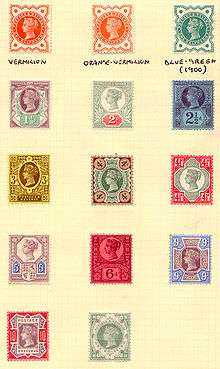Jubilee Issue


The postage stamps of the United Kingdom issued in 1887 are known as the "Jubilee" issue because they were issued during the year of the Golden Jubilee of the accession of Queen Victoria to the throne in 1837. They continued in use throughout the remainder of Victoria's reign, and many of the designs were reused in the stamps of Edward VII. They include the first British stamps to be printed in two colours.
Origins
The variety of colours and designs was partly in response to the much-disliked "Lilac and Green" issues of 1883-1884. The 1884 Stamp Committee was formed to make decisions about improved replacements. After several meetings, and considering a number of essays by De La Rue (many of which survive in the marketplace), they produced a report recommending the use of surface printing, two colours in fugitive inks, coloured paper, and the dropping of the corner letters that had distinguished stamps on the sheet.
Issue
The 1887 issue generally followed the Committee's recommendations and the ½d, 1½d, 2d, 2½d, 3d, 4d, 5d, 6d, 9d and 1s values were put on sale 1 January 1887. A 10d value followed on 24 February 1890 and the 4½d value on 15 September 1892. The stamps continued in use largely unchanged, though specialists identify shade variations, to the end of the century. From 1 January 1900, the halfpenny value was reprinted in blue-green, and the one-shilling value went to a two-colour scheme of carmine rose and green from 11 July 1900.
Values
Because of the lengthy period of use, the lower values of the issue are still quite common today and used copies are worth only a few pennies. Higher values generally rise in price according to the denomination, topped by an unused 1-shilling value, at about 100 pounds. Double impressions of the halfpenny vermilion are known, and go for several thousand pounds.
References
- Stanley Gibbons Great Britain Specialised Stamp Catalogue Volume 1: Queen Victoria (6th edition, 1979)